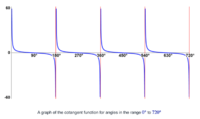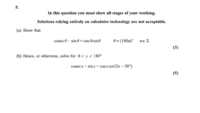Solving this trig equation
- Thread starter Sophie02
- Start date
D
Deleted member 4993
Guest
Please show us what you have tried and exactly where you are stuck.
Please follow the rules of posting in this forum, as enunciated at:
READ BEFORE POSTING
Please share your work/thoughts about this problem
Steven G
Elite Member
- Joined
- Dec 30, 2014
- Messages
- 14,591
You need to look closely at patterns. Pattern recognition is key to mathematics.
I noticed that the four angles in part a were the same.
In part b, with the same formula as in part a, I noticed that three of the four angles were exactly the same. BUT to use this identity in part a ALL the angles must be equal.
What I wrote above is a good hint. Let's see what you can do with it
I noticed that the four angles in part a were the same.
In part b, with the same formula as in part a, I noticed that three of the four angles were exactly the same. BUT to use this identity in part a ALL the angles must be equal.
What I wrote above is a good hint. Let's see what you can do with it
For completeness:
[MATH] \begin{align*}\\ \cos x \cot x=\cos x \cot(3x-50)\\ \cos x(\cot x-\cot(3x-50))=0\\ \therefore \cos x=0 \text{ or } \cot x=\cot(3x-50)\\ \\ 0<x<180, \text{ so } \cos x=0 \rightarrow x=90\\ \\ \cot x=\cot(3x-50) \rightarrow 3x-50&=x+180n\\ x&=25+90n\\ 0<x<180 \rightarrow x=25, x=115\\ \\ \text{The solutions are: }x=\text{ 25, 90, 115}\\ \end{align*}\\[/MATH]
[MATH] \begin{align*}\\ \cos x \cot x=\cos x \cot(3x-50)\\ \cos x(\cot x-\cot(3x-50))=0\\ \therefore \cos x=0 \text{ or } \cot x=\cot(3x-50)\\ \\ 0<x<180, \text{ so } \cos x=0 \rightarrow x=90\\ \\ \cot x=\cot(3x-50) \rightarrow 3x-50&=x+180n\\ x&=25+90n\\ 0<x<180 \rightarrow x=25, x=115\\ \\ \text{The solutions are: }x=\text{ 25, 90, 115}\\ \end{align*}\\[/MATH]
For completeness:
[MATH] \begin{align*}\\ \cos x \cot x=\cos x \cot(3x-50)\\ \cos x(\cot x-\cot(3x-50))=0\\ \therefore \cos x=0 \text{ or } \cot x=\cot(3x-50)\\ \\ 0<x<180, \text{ so } \cos x=0 \rightarrow x=90\\ \\ \cot x=\cot(3x-50) \rightarrow 3x-50&=x+180n\\ x&=25+90n\\ 0<x<180 \rightarrow x=25, x=115\\ \\ \text{The solutions are: }x=\text{ 25, 90, 115}\\ \end{align*}\\[/MATH]
what does the n mean?
Could you show me your working out to see what you think the answer is?You need to look closely at patterns. Pattern recognition is key to mathematics.
I noticed that the four angles in part a were the same.
In part b, with the same formula as in part a, I noticed that three of the four angles were exactly the same. BUT to use this identity in part a ALL the angles must be equal.
What I wrote above is a good hint. Let's see what you can do with it
Sorry, [MATH]n[/MATH] stands for any integer.what does the n mean?
[MATH]\cot \theta[/MATH] has a period of 180º.
When I got to [MATH]x=25 + 90n[/MATH]I used [MATH]n=0[/MATH] and [MATH]n=1[/MATH] to generate the only two solutions for this part, which are between 0º and 180º.
Looking at the graph of [MATH]\cot x^o[/MATH]

it is clear that [MATH]\hspace2ex \cot x = \cot y \hspace4ex \leftrightarrow \hspace4ex x \text{ and } y[/MATH] differ by a multiple of 180º
i.e. [MATH]x-y = 180n[/MATH], (for some [MATH]n \in \mathbb{Z} \text{), } \hspace2ex \text{ i.e. } x=y+180n[/MATH]
That's how I went from:
[MATH]\cot x=\cot(3x-50) \hspace2ex \text{ to } \hspace2ex 3x-50=x+180n[/MATH]
Last edited:

